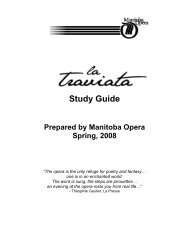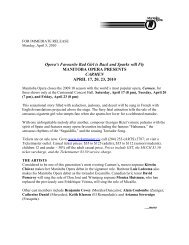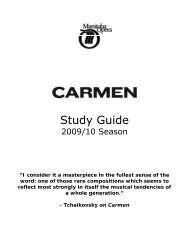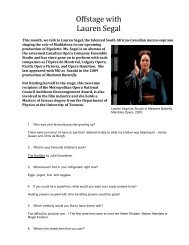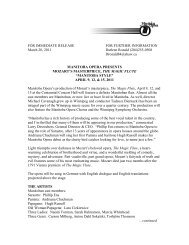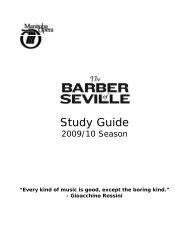The Magic Flute Study Guide - Manitoba Opera
The Magic Flute Study Guide - Manitoba Opera
The Magic Flute Study Guide - Manitoba Opera
You also want an ePaper? Increase the reach of your titles
YUMPU automatically turns print PDFs into web optimized ePapers that Google loves.
OPERA PRODUCTION<br />
<strong>Opera</strong> is created by the combination of myriad art forms. First and foremost are the actors who<br />
portray characters by revealing their thoughts and emotions<br />
through the singing voice. <strong>The</strong> next very important component<br />
is a full symphony orchestra that accompanies the singing<br />
actors and actresses, helping them to portray the full range<br />
of emotions possible in the operatic format. <strong>The</strong> orchestra<br />
performs in an area in front of the singers called the orchestra<br />
pit while the singers perform on the open area called the stage.<br />
Wigs, costumes, sets and specialized lighting further enhance<br />
these performances, all of which are designed, created, and<br />
executed by a team of highly trained artisans.<br />
<strong>The</strong> creation of an opera begins with a dramatic scenario crafted by a playwright or dramaturg who<br />
alone or with a librettist fashions the script or libretto that contains the words the artists will sing.<br />
Working in tandem, the composer and librettist team up to create a cohesive musical drama in<br />
which the music and words work together to express the emotions revealed in the story. Following the<br />
completion of their work, the composer and librettist entrust their new work to a conductor who,<br />
with a team of assistants (repetiteurs), assumes responsibility for the musical preparation of the<br />
work. <strong>The</strong> conductor collaborates with a stage director (responsible for the visual component) in<br />
order to bring a performance of the new piece to life on the stage. <strong>The</strong> stage director and conductor<br />
form the creative spearhead for the new composition while assembling a design team which will take<br />
charge of the actual physical production.<br />
Set designers, lighting designers, costume designers, wig and makeup designers and even<br />
choreographers must all be brought “on board” to participate in the creation of the new production.<br />
<strong>The</strong> set designer combines the skills of both an artist and an architect using “blueprint” plans to<br />
design the actual physical set which will reside on the stage, recreating the physical setting required<br />
by the storyline. <strong>The</strong>se blueprints are turned over to a team of carpenters who are specially trained in<br />
the art of stage carpentry. Following the actual building of the set, painters following instructions<br />
from the set designers’ original plans paint the set. As the set is assembled on the stage, the lighting<br />
designer works with a team of electricians to throw light onto both the stage and the set in an<br />
atmospheric, as well as practical way. Using specialized lighting instruments, colored gels and a stateof-the-art<br />
computer, the designer, along with the stage director, create a “lighting plot” by writing<br />
“lighting cues” which are stored in the computer and used during the actual performance of the opera.<br />
During this production period, the costume designer, in consultation with the stage director, has<br />
designed appropriate clothing for the singers to wear. <strong>The</strong>se designs are fashioned into patterns and<br />
crafted by a team of highly skilled artisans called cutters, stitchers, and sewers. Each costume is<br />
specially made for each singer using his/her individual measurements. <strong>The</strong> wig and makeup designer,<br />
working with the costume designer, designs and creates wigs which will complement both the<br />
costume and the singer as well as represent historically accurate<br />
“period” fashions.<br />
As the actual performance date approaches, rehearsals are held on the<br />
newly crafted set, combined with costumes, lights, and orchestra in<br />
order to ensure a cohesive performance that will be both dramatically<br />
and musically satisfying to the assembled audience.<br />
39<br />
<strong>The</strong> Three Genii in the film,<br />
<strong>The</strong> <strong>Magic</strong> <strong>Flute</strong>, 2006



